Pisa in Tuscany
Pisa is an attractive city located in Tuscany, Italy. It’s best known for its famous leaning tower, which is a must-see attraction, and the lovely Piazza del Duomo, where you’ll find stunning buildings. Pisa has a rich history that goes back to ancient times, and it’s celebrated for its impressive architecture and art. Pisa is home to a well-known university, which gives the city a vibrant and energetic feel. Famous for its charming streets, beautiful river, and rich history, Pisa is a must-visit place for anyone traveling around Italy.
The Piazza del Duomo is a large open space that features some of the most famous monuments in the world. Here, you can find four remarkable medieval buildings: the Cathedral, Baptistry, Leaning Tower, and Camposanto Monumentale(Cemetery). These structures are not only beautiful but have also played an important role in shaping art and architecture in Italy from the 11th to the 14th century.
Table of Contents
Where is the location of Pisa?
Pisa is a charming city located by the Arno River in the Tuscany area of Italy. It’s famous for its Leaning Tower, a unique building that tilts to one side, and the beautiful Piazza del Duomo, a large open square filled with stunning architecture. Pisa has a rich history full of art and architecture, and it also has a lively modern atmosphere, making it a wonderful mix of the past and the present.
Inscription of Pisa
The recognition of Pisa as a UNESCO World Heritage Site celebrates its outstanding cultural and architectural importance. This honor was given in 1987 and focuses on the city’s historic landmarks, especially those in the Piazza del Duomo. Among these landmarks are the famous Leaning Tower, the Cathedral, and the Baptistery, all of which showcase the rich history and beauty of Pisa.
These buildings showcase the Romanesque style of architecture and highlight Pisa’s rich history as a significant maritime city during the Middle Ages. The beautiful combination of artistic heritage and the natural surroundings along the Arno River makes Pisa a remarkable example of a medieval city that has preserved its cultural identity throughout the years.
What is the meaning of Pisa?
The name “Pisa” likely comes from an ancient Greek word meaning “marshy land” or “mouth of a river.” This relates to where the city is located, near the Arno River, suggesting it was established because of its good spot by the water. Throughout its history, Pisa has been important for trade by sea and has played a key role due to its waterways. The name of the city reflects both its natural environment and its past as a busy port.
What is the history of Pisa?
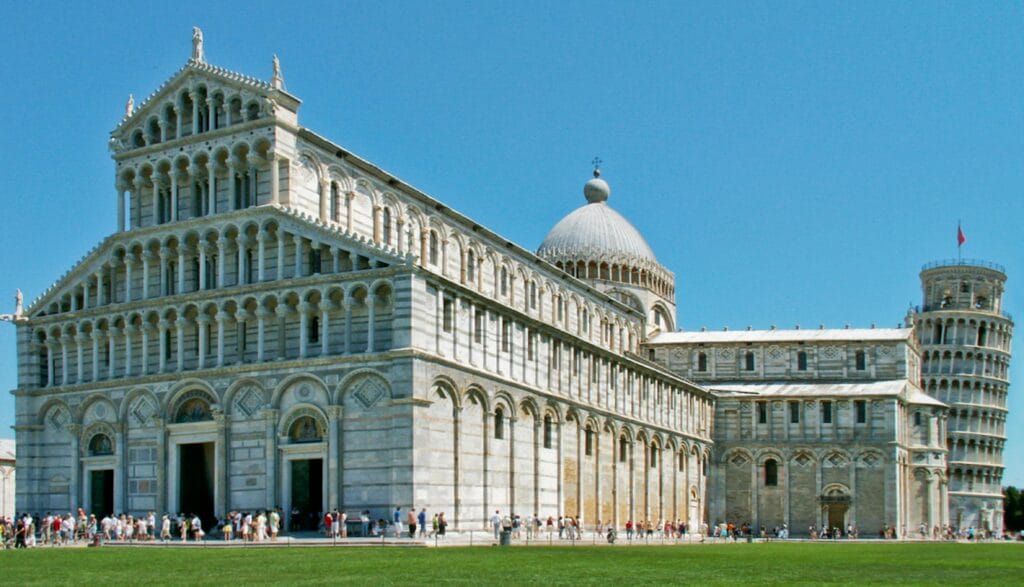
Pisa has a fascinating history that goes back to ancient times. It started as a small settlement by the Etruscans and later became part of the Roman Empire around 180 B.C. Its location by the Arno River made it an important port and trading hub, helping the city grow and thrive over the years. In the Middle Ages, Pisa became a strong maritime city, competing with other Italian cities like Genoa and Venice. The 11th and 12th centuries were a time of great success for Pisa, as it built a powerful navy and grew its trade across the Mediterranean Sea. The city also played an important part in the Crusades, helping supply ships and support for the Christian missions during that time.
The city is famous for its stunning buildings, especially the Leaning Tower of Pisa. This tower is part of a famous area called the Piazza dei Miracoli, which is home to the beautiful cathedral and the Baptistery as well. These sights highlight the city’s rich history and impressive architecture from long ago. Pisa experienced a decline in its prosperity during the late Middle Ages because of battles with other states and the growth of competing ports. By the 15th century, the city was taken over by the Republic of Florence, which further reduced its ability to govern itself.
Today, Pisa is recognized as a significant hub for education and culture thanks to its famous university, which was established in 1343. The city attracts millions of visitors each year who come to admire its historic landmarks and enjoy the lively atmosphere that combines a rich history with modern life.
What is the Pisa is famous for?
Pisa is well-known for its famous Leaning Tower, which is a bell tower beside the city’s cathedral and is famous for its unique tilt. The city boasts stunning buildings, including the Pisa Cathedral and the Baptistery, all situated in an area called the Square of Miracles. Pisa also has a long history of education and is home to one of the oldest universities in the world, the University of Pisa.
What is Piazza del Duomo famous for?
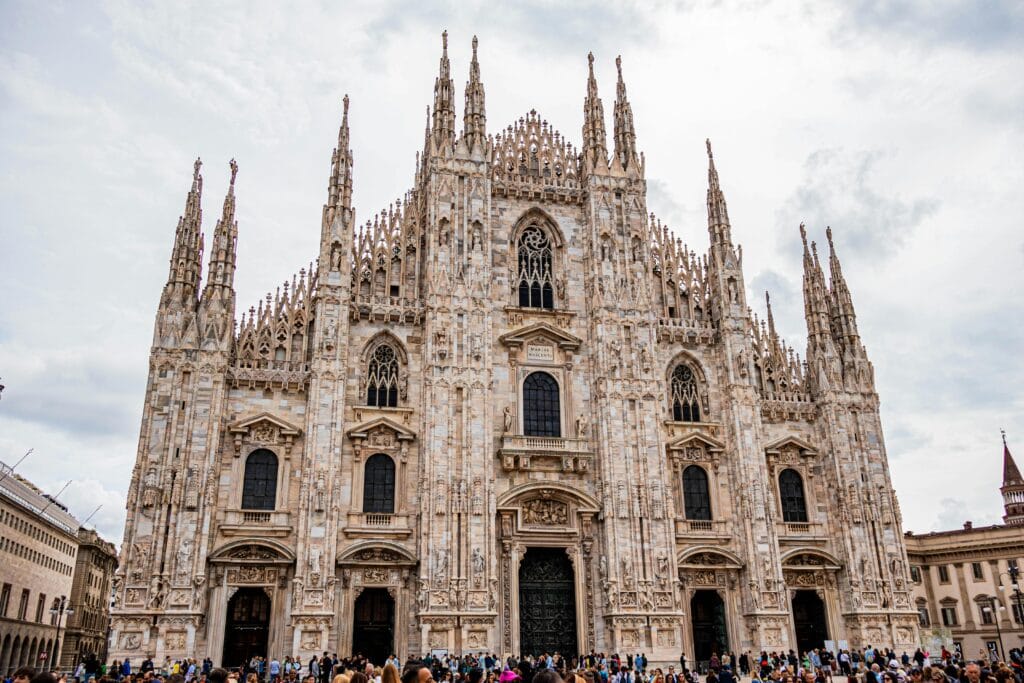
The Piazza del Duomo is a well-known square filled with famous buildings that attract visitors from all over the world. This beautiful area is surrounded by city walls and includes notable sites like the old Ospedale della Misericordia and the Archbishop’s Palace.
Piazza del Duomo is a large public area that has developed since the Middle Ages. Its construction began in 1064 with the building of the new Cathedral and was finished in the 14th century when the actual “square” was created. The area covers 8.87 hectares and has a 254-hectare buffer zone, including all the key elements that show the area’s remarkable universal value.
The buildings in the Piazza del Duomo greatly influenced architecture and art during two important periods. From the 11th century to 1284, when Pisa was thriving, a new style of church design emerged. This style was marked by simpler, colorful architecture and the use of loggias. The Piazza del Duomo in Pisa is among the most recognized man-made places in the world.
Architecture of Pisa
Pisa is famous for its beautiful buildings that mix two different styles: Romanesque and Gothic. The most famous attractions in the city include the Cathedral, the baptistery, the bell tower (which is famously called the ‘Leaning Tower’), and Camposanto Monumentale(Cemetery). These four amazing structures, built between the 11th and 14th centuries, are located close together and together create a special and memorable site filled with history. The Pisa Cathedral, created between the 11th and 12th centuries, is known for its beautiful marble exteriors and striking bronze doors. Inside, you’ll find amazing mosaics and stunning arches that highlight the talent of the builders from long ago.
One notable building is the Baptistery of St. John, which holds the title of the largest in Italy. Its round shape and beautiful exterior showcase the shift from older Romanesque styles to the more modern Gothic style in architecture. Pisa’s buildings showcase a fascinating history and a special artistic style that draws in visitors from all over the globe.
Baptistery of St. John
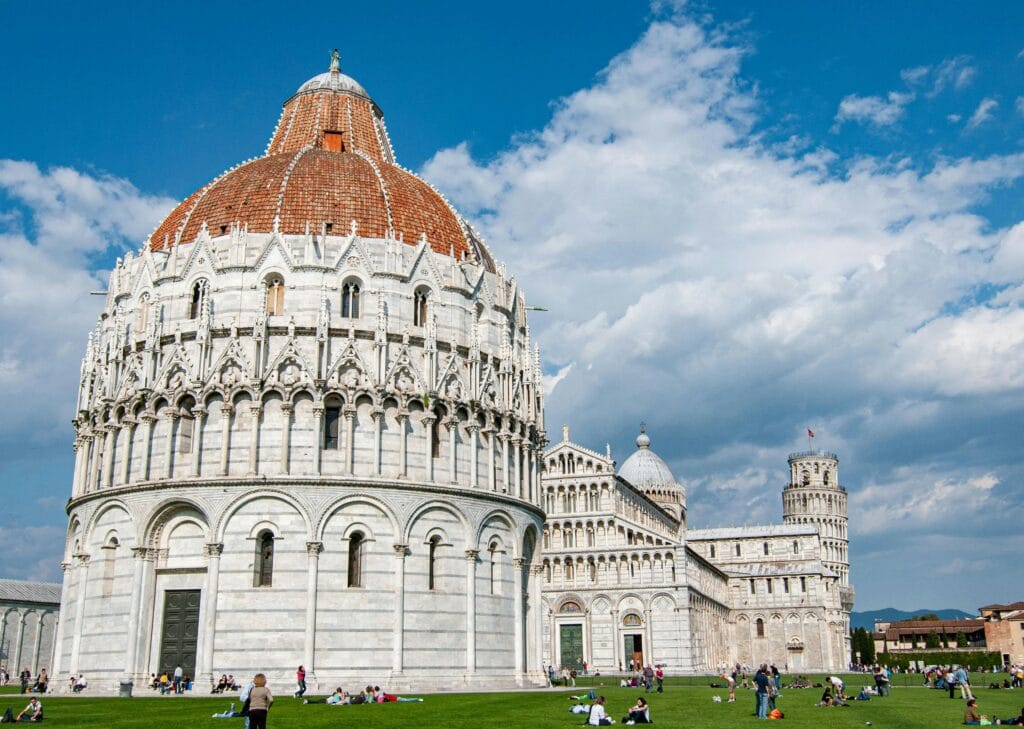
Next to the Cathedral stands the Baptistery, which is the biggest of its kind in Italy. It is famous for its incredible sound quality and breathtaking design. Built in the middle of the 12th and 14th centuries, it combines two architectural styles: Romanesque and Gothic. Inside, you’ll find beautiful sculptures and a special basin used for baptisms. The shape of the dome helps create great acoustics, making it a favorite place for short singing performances.
Leaning Tower of Pisa
The Leaning Tower is a famous bell tower that belongs to the Cathedral of Pisa in Italy. It’s well-known for its unusual tilt, which started when it was being built in the 12th century. The tower is about 56 meters (or about 184 feet) tall and has eight levels, including the area where the bells are located. Visitors can climb 294 steps to enjoy a beautiful view of the area around the tower. Thanks to ongoing repair work, the tower’s lean has been stabilized, making it safer for everyone to visit and admire.
Pisa Cathedral (Duomo di Pisa)
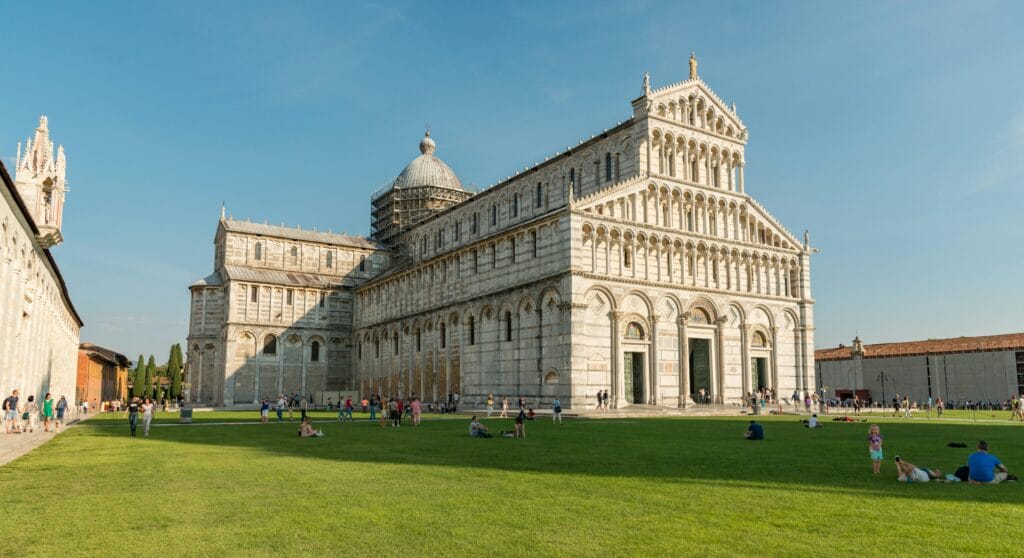
The Cathedral of Pisa, finished in the 11th century, is a breathtaking example of an architectural style known as Romanesque. Its outside walls are decorated with amazing carvings and beautiful marble, combining different artistic influences. Inside, the cathedral is just as striking, featuring colorful mosaics and a large pulpit that draws the eye. It is an important place for worship and is well-known for its incredible beauty and artistic details.
Camposanto Monumentale(Cemetery)
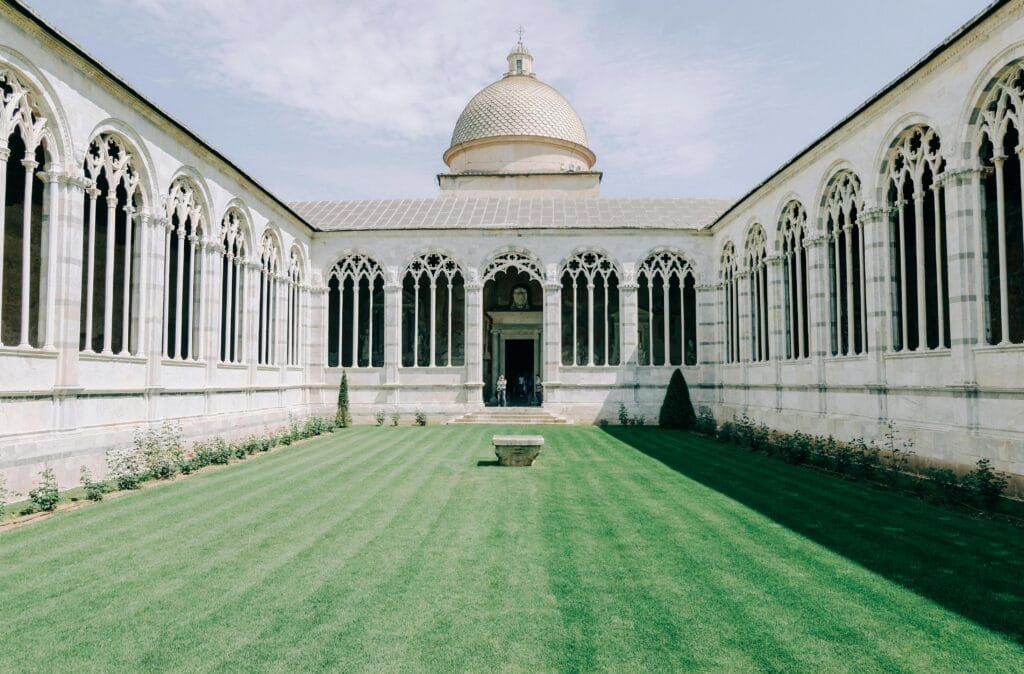
The Camposanto Monumentale(Cemetery), with its beautiful frescoes, is a stunning example of how art and architecture came together during the 14th and 15th centuries in Italy. Situated in the Piazza del Duomo, it is surrounded by various important religious buildings, each designed for a special purpose. Together, these structures highlight the impressive style of medieval Christian architecture and give us a glimpse into that fascinating period.
Art of Pisa
In the 14th century, a talented artist named Giovanni Pisano had a significant impact on the buildings in Tuscany. One of his most notable contributions was the impressive pulpit he created for the Cathedral, which he worked on from 1302 to 1311. His style was grand and left a lasting mark on the region’s architecture.
After the devastating Black Death epidemic, a new style of painting began to take shape, called the Trecento. One of the most famous examples of this art is the “Triumph of Death” fresco created by Bonamico Buffalmacco, which can be found in the Campo Santo around the year 1350. This artwork reflects the themes and emotions of that time and marks an important shift in the world of art.
Observations and Development of Physical Sciences at the Cathedral of Pisa
At the age of 19, Galileo Galilei (1564-1642) made an important observation while watching a bronze chandelier swing back and forth in the Cathedral of Pisa, created by Battista Lorenzi. He noticed that the time it took for the chandelier to swing from one side to the other remained consistent, no matter how far it moved. This insight was a key step in his later discoveries about motion and how objects move, laying the groundwork for significant advancements in science.
At the top of the Campanile, he conducted experiments that helped him understand how objects fall. This work led to important discoveries in the field of physics. As a result, two of the main buildings in the Piazza dei Miracoli are closely connected to a crucial time in the advancement of science.
Preservation of Pisa
Protecting Pisa and its historic sites is important for preserving the city’s cultural heritage. For many years, efforts have been in place to restore and protect significant monuments, especially those in the Piazza del Duomo. These efforts aim to keep the unique architectural styles and historical stories that these landmarks represent safe.
One important effort has been to stabilize and restore the Leaning Tower of Pisa. In recent decades, engineers have used different methods to keep the tower safe for visitors and reduce its tilt. These projects have included stabilizing the soil and reinforcing the foundation, helping to preserve the tower for future generations.
The city has set rules to protect its historical buildings from modern developments. These rules also cover the areas around them, making sure the natural scene along the Arno River stays unchanged. This effort not only makes Pisa look better but also helps keep its historical background.
Pisa is a UNESCO World Heritage Site, highlighting the need for local and global communities to work together to protect its cultural treasures. These efforts help ensure that Pisa continues to attract visitors with its rich history, stunning architecture, and artistry for many years to come.
Why should you visit to Pisa as a visitor?
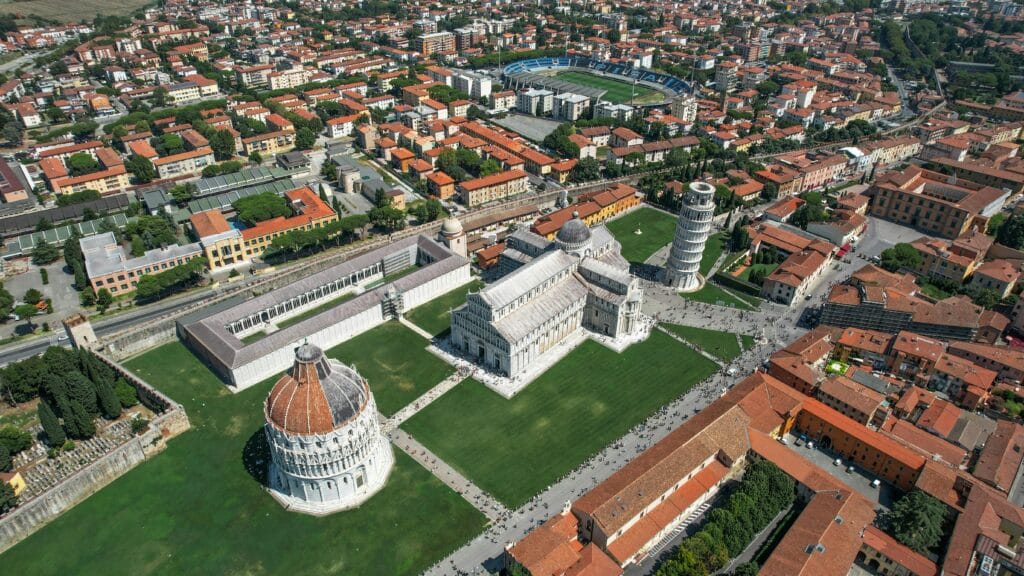
Pisa is a fascinating place filled with history, art, and culture. One of its most famous landmarks is the Leaning Tower, which is definitely worth a visit and showcases incredible medieval design. In addition to the tower, you can wander through the beautiful Piazza dei Miracoli, where you’ll find the lovely Cathedral and Baptistery.
Pisa is a beautiful city known for its lovely streets, lively cafés, and local markets, where you can truly experience Italian culture. Its great location also makes it an ideal starting point for discovering the stunning countryside of Tuscany. Visiting Pisa guarantees unforgettable experiences and amazing views!
Are you interested in experiencing the local cuisine while enjoying the stunning architecture of Pisa?
Pisa is waiting for you! With its amazing historical sites and mouthwatering Italian cuisine, this charming city has a little something for everyone. Be sure to take the time to explore its vibrant culture and breathtaking views. Don’t miss out on all that Pisa has to offer! When you’re planning your adventure, enhance your travel experience by using trusted websites like GetYourGuide and Trip.com! These platforms offer a variety of enjoyable tours, activities, and accommodation options to suit every traveler’s needs.
- GetYourGuide offers a wide variety of unforgettable travel experiences. You can choose from tickets to Popular Attractions, Transportation Options, City Passes, Guided Tours, Hop-on Hop-off Bus Services, Water Activities, Day trips, and Trips that last several days in many locations around the world.
- Trip.com makes it easy to combine Flights and Hotels, Trains, Car Rentals, Airport Transfers and Attractions & Tours to create the perfect travel package tailored just for you.
Start your journey with our reliable travel partners and unlock the best of Pisa and beyond!
Disclaimer
In this post, affiliate links are included and those links are associated with well-known travel companies such as GetYourGuide and Trip.com. If you choose to purchase or book a service using those links, we may earn a commission at no additional cost to you. We focus on recommending products and services that are helpful to you and we appreciate your support!
Conclusion
We hope you find this information helpful for your next trip. If you want to learn more, check out our other travel blog posts. We cover many topics, including amazing places to visit and helpful travel tips. Whether you’re looking for hidden gems, new cultures, or helpful advice, there’s something for everyone.
Additionally, If you enjoyed the information we shared, don’t forget to explore our other travel product reviews to make your journey even better! Please take a moment to look through our previous posts and let your sense of adventure guide you on your next journey! We wish you happy travels and look forward to sharing more with you in our next blog post!




